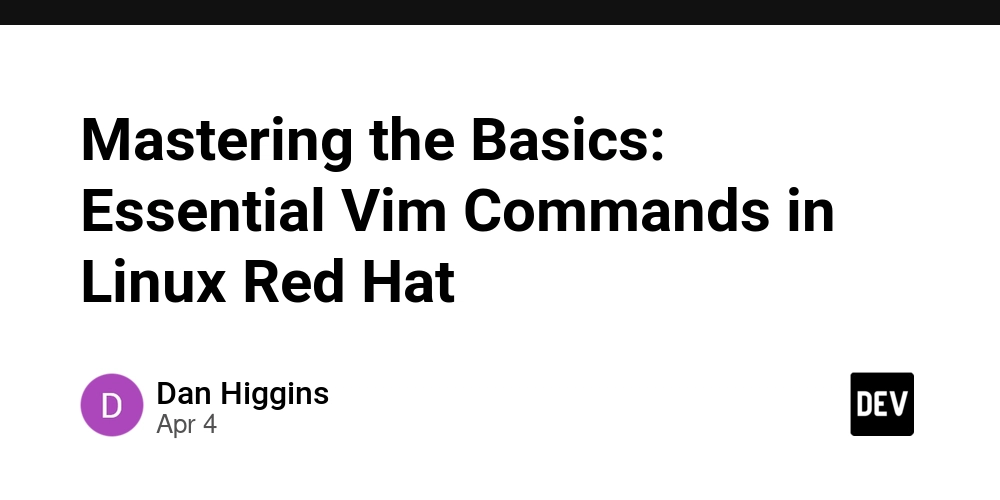Mastering the Basics: Essential Vim Commands in Linux Red Hat
If you’re new to Linux, especially in a Red Hat-based environment, you’ve likely encountered Vim, one of the most powerful text editors available. While Vim is a favorite among seasoned system administrators and developers, it can be a source of frustration for beginners. One of the first challenges? Simply saving and exiting a file! That’s where :wq comes in. Essential Vim Commands and Why They Matter Mastering these commands early on can help you navigate and edit files efficiently in a Red Hat Linux environment. Modes in Vim: Command, Insert, and Extended Mode Vim operates in different modes, and navigating between them is key to using it effectively: Command Mode (default) – Used for navigation, deletion, copying, and executing commands. Press Esc to return to command mode from any other mode. Insert Mode – Used for text editing. Press i to insert before the cursor. Press a to insert after the cursor. Press o to open a new line below. Press O to open a new line above. Extended Mode (Ex Mode) – Used for executing more advanced commands like saving, quitting, and search-replace. Enter extended mode by pressing : (colon), followed by a command (e.g., :wq). Saving and Exiting Vim :wq – Saves changes and exits Vim (write & quit). :q – Quits Vim, but only if no changes were made. :q! – Quits without saving changes. Copying and Deleting Text yy – Copies (yanks) the entire current line. yw – Copies (yanks) a single word. nyy – Copies n number of lines (e.g., 3yy copies 3 lines). dd – Deletes (cuts) the current line. dw – Deletes (cuts) a single word. ndd – Deletes n number of lines (e.g., 3dd deletes 3 lines). Navigation Commands gg – Moves the cursor to the beginning of the file. G – Moves the cursor to the end of the file. ngg or nG – Moves the cursor to line number n (e.g., 10gg moves to line 10). Pasting, Undo, and Redo p – Pastes copied (yanked) or deleted (cut) text after the cursor. u – Undoes the last change. Control + r – Redoes an undone change. Displaying Line Numbers :se nu – Enables line numbers in Vim. :se nonu – Disables line numbers in Vim. Why These Commands Matter for Beginners If you’re working in a Red Hat Linux environment—whether in system administration, DevOps, or cloud computing—Vim will likely be your go-to text editor. Understanding these commands is crucial for: Preventing Accidental Data Loss – :wq ensures your work is saved, while u and Control + r help correct mistakes. Efficient Editing – Copying (yy, yw), deleting (dd, dw), and pasting (p) streamline text manipulation. Quick Navigation – Jumping to specific lines with gg, G, and ngg speeds up workflow. Better Readability – Enabling line numbers with :se nu helps in debugging and script editing. Final Thoughts As a beginner, small wins like mastering these essential Vim commands build confidence and lay the foundation for more advanced Linux skills. Every Linux pro started here! So, the next time you’re working in Vim, remember: These commands will make your experience much smoother. Are you new to Vim? What was your first experience like? Share your thoughts in the comments!

If you’re new to Linux, especially in a Red Hat-based environment, you’ve likely encountered Vim, one of the most powerful text editors available. While Vim is a favorite among seasoned system administrators and developers, it can be a source of frustration for beginners. One of the first challenges? Simply saving and exiting a file!
That’s where :wq comes in.
Essential Vim Commands and Why They Matter
Mastering these commands early on can help you navigate and edit files efficiently in a Red Hat Linux environment.
Modes in Vim: Command, Insert, and Extended Mode
Vim operates in different modes, and navigating between them is key to using it effectively:
Command Mode (default) – Used for navigation, deletion, copying, and executing commands.
Press Esc to return to command mode from any other mode.
Insert Mode – Used for text editing.
Press i to insert before the cursor.
Press a to insert after the cursor.
Press o to open a new line below.
Press O to open a new line above.
Extended Mode (Ex Mode) – Used for executing more advanced commands like saving, quitting, and search-replace.
Enter extended mode by pressing : (colon), followed by a command (e.g., :wq).
Saving and Exiting Vim
:wq – Saves changes and exits Vim (write & quit).
:q – Quits Vim, but only if no changes were made.
:q! – Quits without saving changes.
Copying and Deleting Text
yy – Copies (yanks) the entire current line.
yw – Copies (yanks) a single word.
nyy – Copies n number of lines (e.g., 3yy copies 3 lines).
dd – Deletes (cuts) the current line.
dw – Deletes (cuts) a single word.
ndd – Deletes n number of lines (e.g., 3dd deletes 3 lines).
Navigation Commands
gg – Moves the cursor to the beginning of the file.
G – Moves the cursor to the end of the file.
ngg or nG – Moves the cursor to line number n (e.g., 10gg moves to line 10).
Pasting, Undo, and Redo
p – Pastes copied (yanked) or deleted (cut) text after the cursor.
u – Undoes the last change.
Control + r – Redoes an undone change.
Displaying Line Numbers
:se nu – Enables line numbers in Vim.
:se nonu – Disables line numbers in Vim.
Why These Commands Matter for Beginners
If you’re working in a Red Hat Linux environment—whether in system administration, DevOps, or cloud computing—Vim will likely be your go-to text editor. Understanding these commands is crucial for:
Preventing Accidental Data Loss – :wq ensures your work is saved, while u and Control + r help correct mistakes.
Efficient Editing – Copying (yy, yw), deleting (dd, dw), and pasting (p) streamline text manipulation.
Quick Navigation – Jumping to specific lines with gg, G, and ngg speeds up workflow.
Better Readability – Enabling line numbers with :se nu helps in debugging and script editing.
Final Thoughts
As a beginner, small wins like mastering these essential Vim commands build confidence and lay the foundation for more advanced Linux skills. Every Linux pro started here! So, the next time you’re working in Vim, remember: These commands will make your experience much smoother.
Are you new to Vim? What was your first experience like? Share your thoughts in the comments!






















































.jpg)
%20Abstract%20Background%20112024%20SOURCE%20Amazon.jpg)



















































































































![[The AI Show Episode 142]: ChatGPT’s New Image Generator, Studio Ghibli Craze and Backlash, Gemini 2.5, OpenAI Academy, 4o Updates, Vibe Marketing & xAI Acquires X](https://www.marketingaiinstitute.com/hubfs/ep%20142%20cover.png)
































































































































![From drop-out to software architect with Jason Lengstorf [Podcast #167]](https://cdn.hashnode.com/res/hashnode/image/upload/v1743796461357/f3d19cd7-e6f5-4d7c-8bfc-eb974bc8da68.png?#)




































































































.png?#)





.jpg?#)
































_Christophe_Coat_Alamy.jpg?#)










































































































![Rapidus in Talks With Apple as It Accelerates Toward 2nm Chip Production [Report]](https://www.iclarified.com/images/news/96937/96937/96937-640.jpg)










































































































































